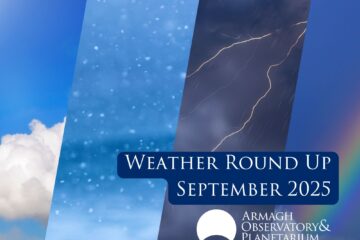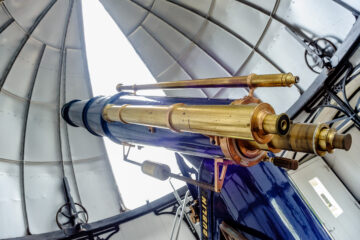Five things to look for during International Dark Sky Week
With a remarkable drop in air-pollution during lockdown and warm weather forecasts, the astronomy experts at Armagh Observatory and Planetarium have shared what twinkling treats you can spot in the sky during International Dark Sky Week.
Step out to the night’s sky this week, let your eyes adjust to the dark surroundings and look out for these top 5 things as you enjoy the clear skies while you Stay at Home:
- Vivid Venus: Shortly after sunset a bright star-like object will be visible in the west above where the sun has set. This will be the planet Venus. Venus is the third brightest object in the night sky after the Sun and Moon, so will be easy to spot even if there are a lot of streetlights and you may even notice it before the sky is fully dark. In ancient times Venus was often called the evening or morning star as its visible shortly before sunrise or shortly after sunset. This is the perfect time to look for Venus as it will be at its brightest on the 25th of April. As we move towards the summer and the longer nights, Venus will no longer be visible.
- New Moon: Even though we use the word moonlight, the moon doesn’t give off any of its own light. Instead it reflects the sunlight back towards the Earth. The moon takes 28 days to orbit the Earth so depending on where the Moon is on its journey, we will see a different part of it illuminated by the Sun. These are called the phases of the Moon. On the 22nd of April we will have a New Moon, this is when none of the moon’s surface is lit up. However, towards the end of the month, you will see the moon growing from a slim crescent moon to a half moon by the 30th. You may also notice the Moon and Venus quite close to each other in the night sky.

- Shooting Stars, The Lyrids Meteor Shower: At certain times of the year, the Earth on its orbit around the Sun moves into areas of cosmic dust often left behind by comets entering into the inner Solar System. As those dust particles enter the Earth’s atmosphere they burn up and create meteors or shooting stars in the night sky. The Lyrids meteor shower peaks on the evening of the 22nd of April and typically you can expect to see up to 20 meteors an hour. They get their name as they seem to originate from the constellation of Lyra which is in the east after Sunset. As the Moon will be in its New Moon phase, the shooting stars will be more visible without the moon’s light interrupting the view. Don’t worry if its cloudy on the 22nd, you can still see a flurry of meteors a few days before and after the peak.

- The Plough: In ancient times, people used the stars to tell stories, mark the changes in seasons and for navigation. Joining stars together like a dot to dot pattern created constellations. One pattern that is well known and easy to spot in our spring sky is the Plough or sometimes also called the Big Dipper. This isn’t a constellation by itself, instead it forms part of a much larger pattern called Ursa Major, the Great Bear. Seven bright stars make up this constellation and they form the shape of a saucepan. Look directly up above your head to spot this shape.
- North Star: Sometimes people think the North Star or Polaris is the brightest star in the night’s sky, but it is not. The reason it is special is because it lies directly above the Earth’s North Pole axis. If you could draw a line way out into space from the North Pole you would eventually arrive at Polaris. So, as the Earth rotates every 24 hours all the stars and constellations move across the sky apart from the North Star. It remains in the same part of the night sky. Therefore, it has been used for navigation for thousands of years. To find the North Star look to the Plough pattern, and use the two stars opposite the handle, they are called the Pointer stars and follow them upwards until you reach the North Star.
Armagh Observatory and Planetarium Operations Manager, Martina Glass said: “We are very fortunate to have particularly clear skies at the moment and an opportunity to really enjoy the stars and galaxy above us, even from the naked eye. Although we aren’t welcoming visitors to Armagh Planetarium at the moment, we still would encourage star gazers to enjoy the night’s sky even from their own home this International Dark Sky Week, with clear skies forecast all week. We should be in for a treat with the likes of the Lyrids Meteor Shower, fingers crossed you see some shooting stars!
“Our team are still working hard to bring science and star-gazing fun to families at home, until we can warmly welcome you again to Armagh. Have a look on our Facebook and YouTube to try some of our ‘Science at Home’ experiments too.”
Follow Armagh Observatory and Planetarium on Facebook. For a full programme of events once the centre has re-opened visit www.armagh.space



0 Comments